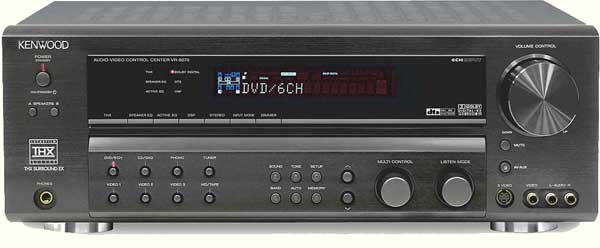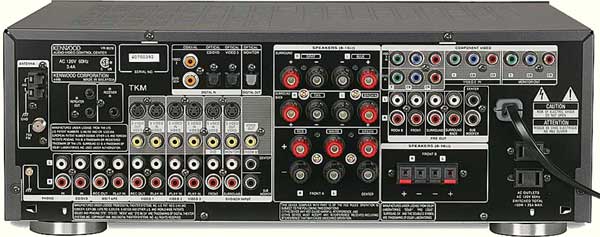|
|
 |
|
Specifications
●
Codecs: DD, DD-EX, DPL-IIx, DTS, DTS-ES, DTS
Neo:6, THX Surround EX
●
Power: 100 Watts per Channel x 7
●
Inputs/Outputs: Three Component Video
In/Out, Five S-Video, Five Composite Video,
Two Coaxial Digital, Two Toslink Digital, Eight
Pre-Outs
●
MSRP: $600 USA
Kenwood
www.kenwoodusa.com
|
|
Introduction
When at first I was asked to review a mid-priced receiver, I was somewhat
disappointed, as my quest for the $20,000 amplifier continued. My first
thought was could I really expect much more than basic features at such a
reasonable price point?
Kenwood has not disappointed in the least with their
VR-8070 A/V Surround Sound Receiver. The VR-8070 is as full and feature packed as receivers that are
significantly more expensive. This review is a continuation of the “Budget
Receiver Roundup” series that is currently ongoing at Secrets.
The Design
Introduced in May, 2004, the Kenwood VR-8070 was the industry’s first 7.1
channel THX Select receiver at the $600 price point. THX Select is the
performance benchmark for mid-priced home theater systems. The designation
is used for smaller speakers and smaller rooms, which if you are like most of us, describes your listening environment.
The VR-8070 incorporates high end features beyond the THX-Select certification,
such as 24-bit/96kHz digital-to-analog audio conversion, HD component video
switching (meaning the bandwidth is high enough to switch HD signals), digital inputs and outputs, and THX Surround EX and DTS-ES audio
decoding. The seven audio channels are driven by Kenwood’s proprietary K-STAT
(Kenwood – Self Tracking Audio Transistor) Discrete Audio Amplifier Technology
to 100-watts RMS each.
Satisfying the designer in each of us, Kenwood offers the VR-8070 in both
silver and - my preference - midnight black, sure to match your existing décor.
All of this means that you get a lot of receiver with powerful audio
processing and the latest technology for your money.
The
Front Panel

The clean well organized look of the front panel is well laid out and easy to
navigate. The source inputs are grouped together, as are the power and speaker
selection buttons. There is a Multi-Control knob to handle most of the setup
functions for speaker setup, and test tones. There is also a Listen Mode knob
for all of the various Dolby and THX modes. With the Listen Mode there is
also a setting for Auto Detect which corresponds to your selected input and
will allow the receiver to automatically select the optimal listening mode
based on the type of input signal and the speaker settings. I found the Auto
Detect worked very well in detecting the mode to play movies and music.
The volume
control is large and off to the right. It felt as if you had
to turn the knob quite far to achieve a small change in sound, and this is
good for making fine changes in volume. For easy access, the
front panel includes not only composite video and stereo inputs, but an S-Video
input as well allowing you to connect an additional component such as a video
camera, or in my case an iPod. There is also a convenient headphone jack. The
display is a fluorescent blue with some red that is dimmable.
It is refreshing to have a receiver that you can control completely without
the remote and allows you to perform all of the system setup from the front panel
in a logical manner, but without having an overabundance of knobs and buttons.
The Rear Panel

The connections are intelligently grouped by source and function, making them
easy to follow. Some of the nice functions include pre-outs for each of the
speaker groups, as well as composite video and stereo outs for a second zone
or room. With the thoughtful inclusion of the IR sensor input as well as the
two IR repeater outputs, this allows for the sending of the audio or video signals
to be controlled in the second zone. It also allows for greater flexibility in
placement of the unit, such as inside of a cabinet or other location out of
the line-of-sight of the universal remote.
For a receiver at this price point,
the logical layout makes it extremely easy for the novice user to complete the
set-up. The printed instruction manual is also very well laid out with many
pictures, diagrams, and flow charts to accommodate virtually all sources and
set-up needs.
Once all of the connections have been made, the speaker set-up can be
accomplished through the remote or front panel. The included manual logically
lays out a flow chart of the various settings as well as nice descriptions of
what each of the settings does. In the setup mode, there is also a test tone
function to cycle through your speakers and levels.
 The Remote
Control The Remote
Control
The remote is well laid out and ergonomically feels good to hold. There are
source buttons laid out across the top to control both Kenwood and non-Kenwood
products. There were plenty of buttons to accommodate the programming and
function of up to nine TV, DVD, and other source components' main functions. The
layout of the buttons is intelligent and easily memorized, although the
inclusion of a backlight would be a nice addition. I was also somewhat
disappointed with the line of sight of the remote in that it needed to be
pointed directly at the unit rather than just generally in the direction of
the receiver.
In
Use
The overall set-up, installation, and use of the VR-8070 was very easy.
As to my spouse, she was able to figure out the remote and switching
between inputs and sound modes the first day of use.
With movies, the sound field created by the unit was very convincing. The
dialog was clear, no more backing up to catch that last line. The bass was
authoritative, and while it lacked a huge chest pounding thump, it was more than
enough to get your attention.
The Neo:6 mode which produces 6.1 channels from stereo sources was very
nice for taking older Dolby Pro Logic encoded movies in my collection and
introducing discrete sounds in the surround channels. While using Neo:6, I did
not detect any sounds from the surround speakers that sounded out of place. It
truly created a three-dimensional soundstage surrounding me with warmth and
sound.
While listening to music I utilized the additional Music mode controls,
including the Panorama effect which created a seamless wraparound sound effect
from two-channel stereo that was very nice with jazz tracks.
It was also notable that the VR-8070 ran very cool compared to other amps that
I have had in its place, a welcome relief to some of the larger space heaters I
have used.
Keeping in mind that THX Select caters to a smaller room, the Kenwood filled
the room wonderfully, but don’t expect it to fill a grand ballroom.
Conclusions
In a world of people settling for less or with the attitude of, "You get what you
pay for," being pervasive, the VR-8070 clearly gives you much more than you pay
for. I do not believe that in this price range you could find a more solid
performer than the Kenwood VR-8070. Considering you can buy this unit on the
street in the $500 price range, the 8070 is a receiver not to be overlooked when
you are ready to enhance your sound experience and have some money left over for the
mortgage.
- Scott A. Taillie -
Terms and Conditions of Use

|




 The Remote
Control
The Remote
Control

